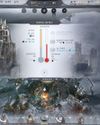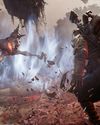
PCs are ten, maybe even fifteen, years behind where they should be. That sounds a lot, but actually makes a lot of sense if you remember what PCs were like in 2005 (spoiler: The same as they are now). Bell’s Law, a companion to Moore’s Law, states that every decade, a new and lower-priced computer class forms that leads to the establishment of a new industry.
This hasn’t happened. The desktop PC wasn’t out-competed by the laptop, and the laptop wasn’t bullied out of its evolutionary niche by phones and tablets. We’ve got all three, at the same time, and the one you want always costs $1,000.
This month’s Tech Report was meant to be about the future of chip cooling, and it kind of still is, but it also touches on the implications of Bell’s Law, and how hot new computer architectures, supplied with new cooling systems, could be about to overturn the hierarchy of our PCs and devices.
We’ve been actively cooling our CPUs since the days of the 486 (introduced in 1989), and today’s multi-core monsters may have fans all over, with intakes and outflows on their cases, AIO or hard-piped liquid cooling radiators cooled by three fans, three more on the graphics card, and even a few on sensitive parts of the motherboard. The number and size have increased, but we’re still basically in the same place we were with Pentium II machines.
“We haven’t reinvented the computer, and that is a problem,” says Dr Bruno Michel of IBM’s Zurich Research Laboratory, Switzerland. “We’re using an overaged technology, when what we should use is the newest technology which we have available.”
Bu hikaye PC Gamer US Edition dergisinin April 2021 sayısından alınmıştır.
Start your 7-day Magzter GOLD free trial to access thousands of curated premium stories, and 9,000+ magazines and newspapers.
Already a subscriber ? Giriş Yap
Bu hikaye PC Gamer US Edition dergisinin April 2021 sayısından alınmıştır.
Start your 7-day Magzter GOLD free trial to access thousands of curated premium stories, and 9,000+ magazines and newspapers.
Already a subscriber? Giriş Yap

"The War Within itself has kept me coming back most evenings too"
WORLD OF WARCRAFT remains my jailer, and I couldn't be more pleased about it

OK BUILDER
SATISFACTORY is the new titan in building and crafting games

HELL YES
DIABLO IV: VESSEL OF HATRED is a transformative expansion

MOUSE: PI FOR HIRE
This mouse wants to be more than just a gimmick

WINDBLOWN
Dead Cells dev's new roguelike has me afraid for my free time

NO MORE ROOM IN HELL 2
As the zombie horde surrounded me just moments after taking down my two remaining teammates, the writing was really on the wall. Armed with just a chef's knife, it was clear I stood no chance, but I was going down swinging, hoping for a miracle... it didn't come.

OWNED BY STEAM
VALVE cordially reminds you that your games aren't yours

CURSE OF THE AZURE BONDS
These classic games haven't aged badly, but I sure have.

DEEP FREEZE
Endure a blizzard of tough choices and rough consequences in FROSTPUNK 2

NEW HORIZONS
Building up REMNANT 2 outside the live service game grinder